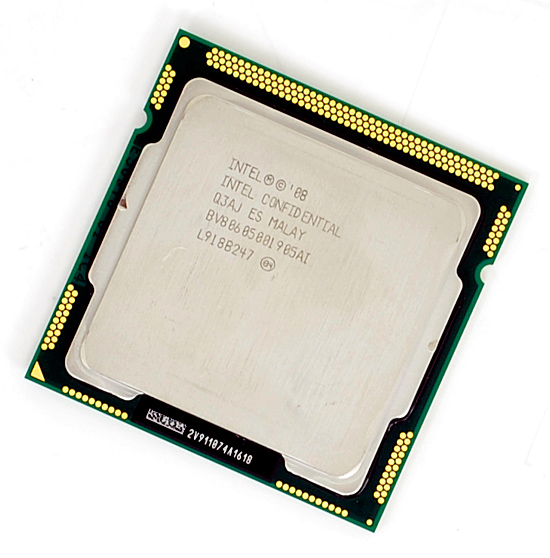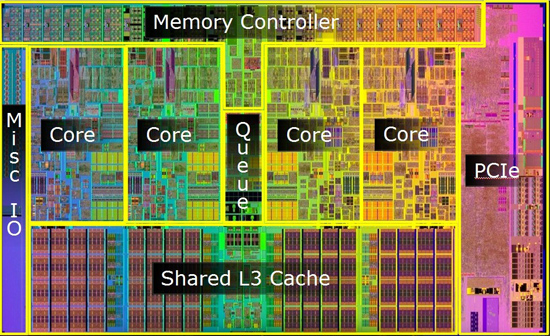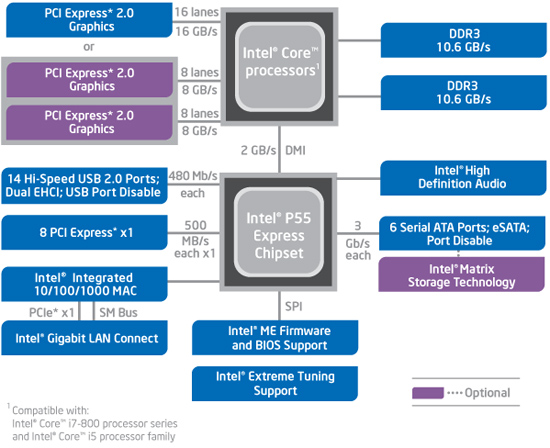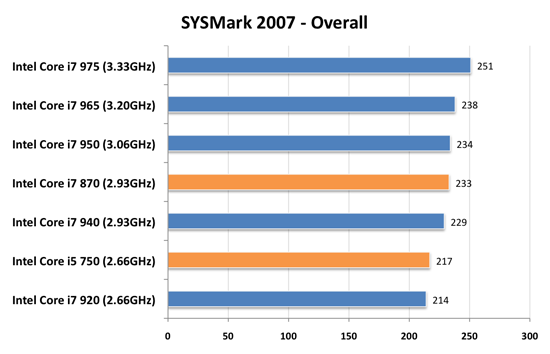Intel's Core i7 870 & i5 750, Lynnfield: Harder, Better, Faster Stronger
by Anand Lal Shimpi on September 8, 2009 12:00 AM EST- Posted in
- CPUs
Intel is on the verge of transitioning to 32nm. We'll see the first parts this year. What do you do with your 45nm fabs when you start moving volume away from them? Make really cheap quad-core Nehalems of course:

I'm talking $196. I'm talking faster than AMD's entire lineup. I'm talking about arguably the best processor of 2009. I'm talking about Lynnfield, and here's its backside:

Mmm
I spent much of the past year harping on AMD selling Nehalem-sized Phenom IIs for less than Intel sold Nehalems. With Lynnfield, Intel actually made Nehalem even bigger all while driving prices down. Like I said, what do you do when you're still making boatloads of money in a recession and are about to start emptying your 45nm fabs?
I should clear things up before we progress much further. Lynnfield is the codename for mainstream 45nm quad-core Nehalem, while Bloomfield refers to the first Nehalem launched at the end of 2008:
| Processor | Manufacturing Process | Die Size | Transistor Count | Socket |
| Bloomfield | 45nm | 263 mm2 | 731M | LGA-1366 |
| Lynnfield | 45nm | 296 mm2 | 774M | LGA-1156 |
Despite being cheaper, Lynnfield is larger than Bloomfield. The larger die is due to one major addition: an on-die PCIe controller.

Bloomfield, The First Nehalem, circa 2008

Lynnfield, Nehalem for All, circa 2009
The pink block to the right of the die is the PCIe controller, that's 16 PCIe 2.0 lanes coming right off the chip. Say hello to ultra low latency GPU communication. You'd think that Intel was about to enter the graphics market or something with a design like this.
Sacrifices were made to reduce CPU, socket and board complexity. Gone are the two QPI links that each provided 25.6GB/s of bandwidth to other CPUs or chips on the motherboard. We also lose one of the three 64-bit DDR3 memory channels, Lynnfield only has two like a normal processor (silly overachieving Bloomfield).

Intel's Bloomfield Platform (X58 + LGA-1366)
The sum is that Lynnfield is exclusively single-socket; there will be no LGA-1156 Skulltrail. While the dual-channel memory controller isn't really a limitation for quad-core parts, six and eight core designs may be better suited for LGA-1366.

Intel's Lynnfield Platform (P55 + LGA-1156)
The loss of QPI means that Lynnfield doesn't have a super fast connection to the rest of the system, but with an on-die PCIe controller it doesn't matter: the GPU is fed right off the CPU.
The Lineup
We get three Lynnfield CPUs today: the Core i7 870, Core i7 860 and the Core i5 750. Intel's branding folks told us that the naming would make sense one we saw the rest of the "Core" parts introduced; yeah that was pretty much a lie. At least there aren't any overlapping part numbers (e.g. Core i5 860 and Core i7 860).
The i7 in this case denotes four cores + Hyper Threading, the i5 means four cores but no Hyper Threading. The rules get more complicated as you bring notebooks into the fray but let's momentarily bask in marginal simplicity.
| Processor | Clock Speed | Cores / Threads | Maximum Single Core Turbo Frequency | TDP | Price |
| Intel Core i7-975 Extreme | 3.33GHz | 4 / 8 | 3.60GHz | 130W | $999 |
| Intel Core i7 965 Extreme | 3.20GHz | 4 / 8 | 3.46GHz | 130W | $999 |
| Intel Core i7 940 | 2.93GHz | 4 / 8 | 3.20GHz | 130W | $562 |
| Intel Core i7 920 | 2.66GHz | 4 / 8 | 2.93GHz | 130W | $284 |
| Intel Core i7 870 | 2.93GHz | 4 / 8 | 3.60GHz | 95W | $562 |
| Intel Core i7 860 | 2.80GHz | 4 / 8 | 3.46GHz | 95W | $284 |
| Intel Core i5 750 | 2.66GHz | 4 / 4 | 3.20GHz | 95W | $196 |
Keeping Hyper Threading off of the Core i5 is purely done to limit performance. There aren't any yield reasons why HT couldn't be enabled.
Intel was very careful with both pricing and performance of its Lynnfield processors. I'm going to go ahead and say it right now, there's no need for any LGA-1366 processors slower than a Core i7 965:

This is only one benchmark, but it's representative of what you're about to see. The Core i7 870 (LGA-1156) is as fast, if not faster, than every single LGA-1366 processor except for the ones that cost $999. Its pricing is competitive as well:

For $196 you're getting a processor that's faster than the Core i7 920. I'm not taking into account motherboard prices either, which are anywhere from $50 - $100 cheaper for LGA-1156 boards. I don't believe LGA-1366 is dead, but there's absolutely no reason to buy anything slower than a 965 if you're going that route.










343 Comments
View All Comments
Supershanks - Thursday, September 10, 2009 - link
Great Article Anand, I read it with great interest.However I found somthing that was strange and unexpected today
My I7-860 was running at 30x133 3990 when running nucleus, that's according to cPU-z I have a link , but can't post http in this comment ?
http://www.clunk.org.uk/forums/reviews/24295-asus-...">http://www.clunk.org.uk/forums/reviews/...-deluxe-...
I'd appreciate your insight ?
thanks
Gary Key - Thursday, September 10, 2009 - link
You need to change your version of CPU-Z. I have a screenshot somewhere around here of 48x133. ;)Scali - Thursday, September 10, 2009 - link
On a slightly related note... With these new P55 boards I see that especially Asus uses a new line of onboard audio chips from VIA.I haven't really been able to find much info on these chips. I'd like to know how they compare to Realtek and other onboard offerings.
Could you guys spend some time on reviewing the onboard audio next time you review one of these boards? Eg, what does the control panel for these chips look like, what features does it have (eg, can you have realtime encoding like DTS connect or DD Live?), what is the general driver quality like (proper support of 3d/eax effects etc)?
I think that's what's been missing in general, the past few years. Onboard audio has gotten quite advanced, to the point where most people no longer use a separate soundcard (some boards actually come with some sort of X-Fi card). However, I rarely see onboard audio reviewed, only audio cards.
agawtrip - Thursday, September 10, 2009 - link
for me, i find this review is misleading if you are not a gamer - for i5-750 and PII x4 965.why?
1. motherboard and video card - non-gamer dont buy sli/xfire board. onboard graphics is fine(780g/785g). for now, boards for i5 setup doesn't have onboard graphics. what will you do? you will be forced to buy a video card (maybe 4550/9400gt for $40).
i5-750 - $195, GIGABYTE GA-P55M-UD4 - $150, nvidi 9400gt - $40
--- TOTAL -------- $385
PII x4 965 - $245, GIGABYTE GA-MA785GMT-UD2H - $90, no video card
--- TOTAL -------- $335
AMD setup is actually cheaper but slower. it's all up to you.
2. power consumption - since you are forced to buy video card, it will consume additional power while AMD setup (780/785G) won't.
well that's just my opinion.
please inform me and the others if i given up wrong informatin
chrnochime - Thursday, September 10, 2009 - link
Or you can get a motherboard that's quite a bit cheaper:MSI P55-CD53
http://www.newegg.com/Product/Product.aspx?Item=N8...">http://www.newegg.com/Product/Product.aspx?Item=N8...
which is 120..
or
GIGABYTE GA-P55M-UD2
http://www.newegg.com/Product/Product.aspx?Item=N8...">http://www.newegg.com/Product/Product.aspx?Item=N8...
And yes I know these are NE prices, and that it might be more expensive/cheaper somewhere else
Hrel - Wednesday, September 9, 2009 - link
It DOES NOT have hyperthreading. Enabling it wouldn't increase the cost of the chip, it purely a political move. I HATE that! If a CPU maker has something that can increase the performance of my cpu, at no cost to them, then should enable it, at no cost to me. EVERY CPU should have unlocked multipliers. EVERY CPU should have hyperthreading.jnr0077 - Friday, July 27, 2012 - link
hyperthreading steal ram from your pc i have a i5 750 + radeon hd 4850 it plays crysis 2 maxed the witcher 2 maxed skyrim maxed i think you need to read up on it before you comment :)PhilTaylor - Wednesday, September 9, 2009 - link
FSX is well known as a CPU-limited game, it might be more interesting to test it then a GPU limited game like Crysis. For instance, the difference between 2 and 3 memory channels might have a greater impact on FSX, again due to its CPU-limited nature.cactusdog - Wednesday, September 9, 2009 - link
A very good, detailed bunch of tests but there is a surprising lack of information regarding temps? Other review sites have done the same thing but there IS temp issues with these CPUs as with i7 1366 ones. That CPU at 4.0 Ghz on air will be around 90 degrees but little is said.Anandtech is more honest than most review sites (most of which are really just advertisements) but sometimes i get the impression that nobody wants to upset Intel.
araczynski - Wednesday, September 9, 2009 - link
...bottom line to me, my E8500/crossfire setup still has plenty of gaming life left. I'll check back in a year.